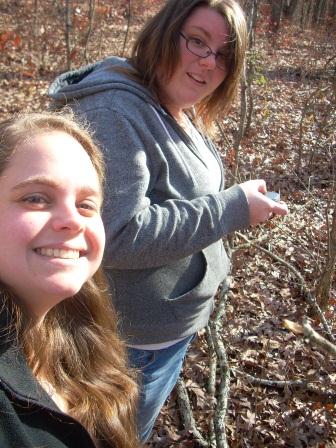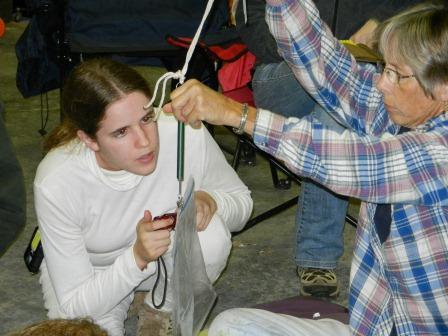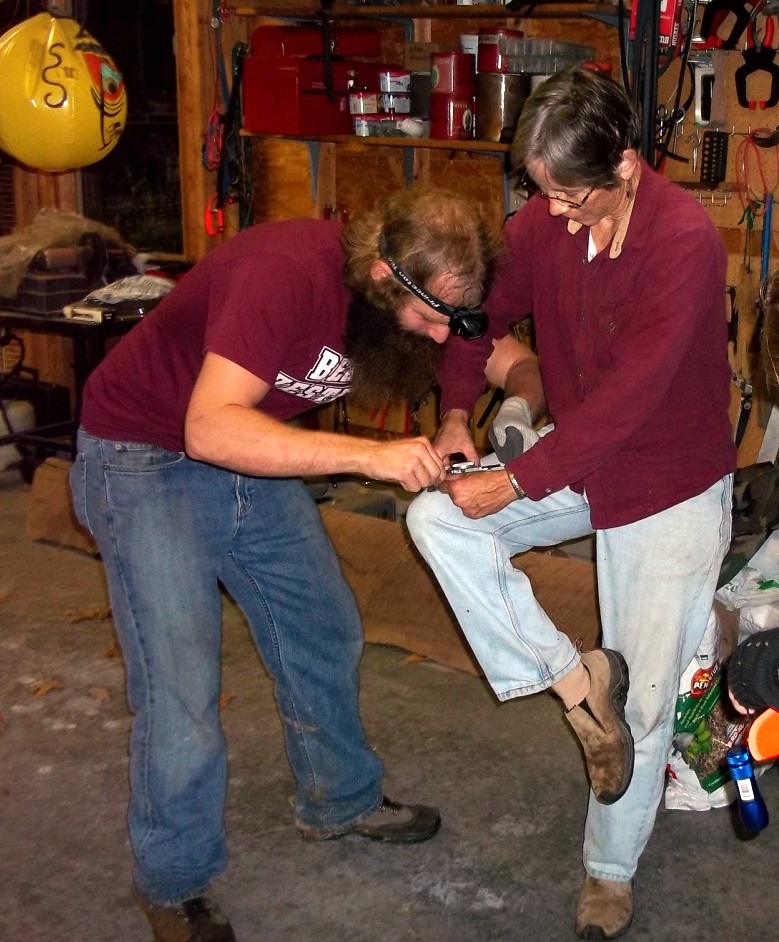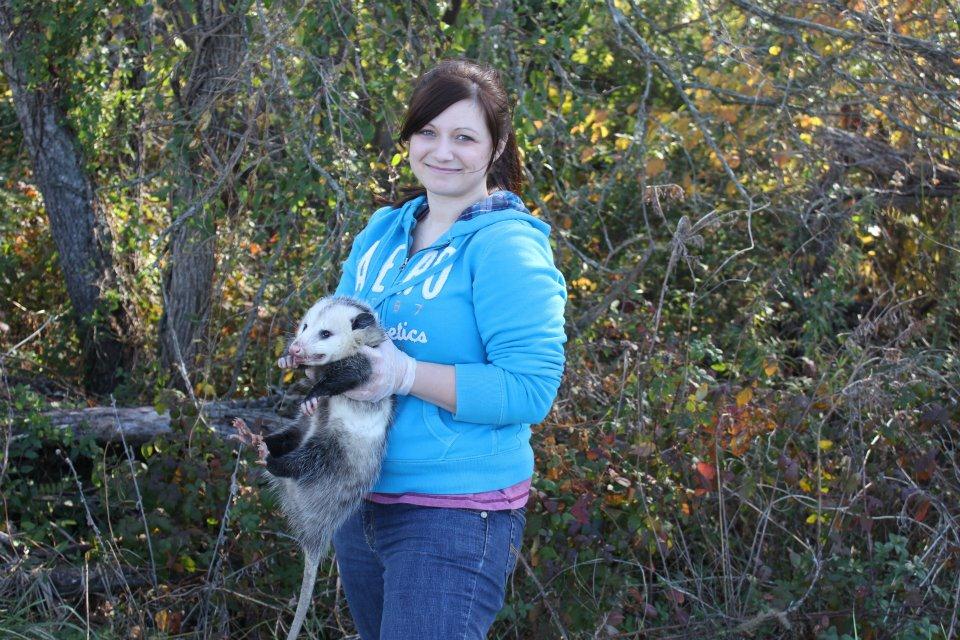Mammal
Abstracts 2011
Eastern Gray Squirrel (Sciurus carolinensis) Distributions
in Urban and Forested Areas
Courtney Fouts and Eleanor Stone
 Using index counts, we counted squirrels in urban areas in Murray, KY and forested areas in Land Between the Lakes to observe the differences in distributions of Eastern gray squirrel (Sciurius carolinensis) populations in a heavily human populated area and an area with little human activity. Research showed that urbanization decreases natural populations of many animals, including squirrels. But the Eastern gray squirrel (Sciurus carolinensis)is a common creature to see in any neighborhood within their natural distribution, so we sought to determine how there could be an evident population of squirrels in urban areas, but still have their numbers decrease due to their lack of habitat. To test this, we measured 5 random sites in Land Between the Lakes and 7 sites in Murray, KY. We counted squirrels randomly for 10 days. The two sites were compared and we found there were more squirrels in urban areas because they are much more highly congested in urban areas than forested areas. Using index counts, we counted squirrels in urban areas in Murray, KY and forested areas in Land Between the Lakes to observe the differences in distributions of Eastern gray squirrel (Sciurius carolinensis) populations in a heavily human populated area and an area with little human activity. Research showed that urbanization decreases natural populations of many animals, including squirrels. But the Eastern gray squirrel (Sciurus carolinensis)is a common creature to see in any neighborhood within their natural distribution, so we sought to determine how there could be an evident population of squirrels in urban areas, but still have their numbers decrease due to their lack of habitat. To test this, we measured 5 random sites in Land Between the Lakes and 7 sites in Murray, KY. We counted squirrels randomly for 10 days. The two sites were compared and we found there were more squirrels in urban areas because they are much more highly congested in urban areas than forested areas.
Study of Bait Effectiveness for Common Mammalian Species of Western Kentucky
Corrine McCreary and Amy Szerletich
  Trapping is an essential part of many biological experiments; however there are few studies on the topic of improving trapping efficiency where a 10% success rate is excellent. Our experiment is to test which bait is more effective, ripe apple or overripe apple. We hypothesize the overripe will be more effective because it can be smelled from a further distance. Our results have proven otherwise as there is no significant difference between ripe bait and overripe bait. Despite this our trapping success was 29%, so future experimentation must be done to determine why we were so successful when the bait made no difference. Trapping is an essential part of many biological experiments; however there are few studies on the topic of improving trapping efficiency where a 10% success rate is excellent. Our experiment is to test which bait is more effective, ripe apple or overripe apple. We hypothesize the overripe will be more effective because it can be smelled from a further distance. Our results have proven otherwise as there is no significant difference between ripe bait and overripe bait. Despite this our trapping success was 29%, so future experimentation must be done to determine why we were so successful when the bait made no difference.
Habitat Fragmentation: A Comparison of Small Non-Volant Mammalian Species Diversity
in Urban and Rural Woods
Leslie Potts and Alexandra Schindler
 Species diversity is greatly influenced by habitat fragmentation. Our research serves to exploit any differences in diversity between areas of rural and urban fragmentation of small non-volant mammals. These species are important because they are the main primary consumers of ecosystems, aid in maintenance of the habitat and are a main food source for secondary consumers. Our alternate hypothesis was small mammal diversity would be greater in areas of rural fragmentation. We used ten wooded sites, five in areas of rural fragmentation and five in urban. Sherman traps were checked at twelve hour intervals for 5 trap-nights and captured animals were identified and tagged before release. To measure diversity we used the Shannon index, to compare the results we used the Mann-Whitney U test (unpaired non-parametric t-test). Our null hypothesis was supported showing no significant difference between the two types of habitat fragmentation. Species diversity is greatly influenced by habitat fragmentation. Our research serves to exploit any differences in diversity between areas of rural and urban fragmentation of small non-volant mammals. These species are important because they are the main primary consumers of ecosystems, aid in maintenance of the habitat and are a main food source for secondary consumers. Our alternate hypothesis was small mammal diversity would be greater in areas of rural fragmentation. We used ten wooded sites, five in areas of rural fragmentation and five in urban. Sherman traps were checked at twelve hour intervals for 5 trap-nights and captured animals were identified and tagged before release. To measure diversity we used the Shannon index, to compare the results we used the Mann-Whitney U test (unpaired non-parametric t-test). Our null hypothesis was supported showing no significant difference between the two types of habitat fragmentation.
Morphological differences between Peromyscus leucopus caught in rural and urban environments
Logan Johnson
 Many studies concerning the effects of urbanization on wildlife have been done, but there is little known concerning morphological responses that animals may have to compensate for these changes. In this study Peromyscus leucopus were captured using Sherman traps in 5 wood plots in urban locations and 3 wooded areas in rural locations. Lengths of the tail, body, hind foot, head, ear, nose to eye, nose to posterior end of masseter, hand to olecranon process, and weight were recorded for each mouse. Each measurement was then turned into a ratio over the body length to attempt to reduce size variation due to age. Juvenile and sub adults were excluded from the comparison to eliminate variations due to allopatry. The ratios were analyzed using ANOVA, resulting in significant differences in tail, hind foot, and masseter/body. Many studies concerning the effects of urbanization on wildlife have been done, but there is little known concerning morphological responses that animals may have to compensate for these changes. In this study Peromyscus leucopus were captured using Sherman traps in 5 wood plots in urban locations and 3 wooded areas in rural locations. Lengths of the tail, body, hind foot, head, ear, nose to eye, nose to posterior end of masseter, hand to olecranon process, and weight were recorded for each mouse. Each measurement was then turned into a ratio over the body length to attempt to reduce size variation due to age. Juvenile and sub adults were excluded from the comparison to eliminate variations due to allopatry. The ratios were analyzed using ANOVA, resulting in significant differences in tail, hind foot, and masseter/body.
Age distribution of Road-killed Whitetail Deer (Odocoileus virginianus)
Aaron Lane and Phillip Geyer

The purpose of this research was to firstly, to analyze the ages of road-killed whitetail deer (Odocoileus virginianus) and see what the distribution was and secondly to compare those ages to the age distribution of the herd and see if there was any correlation. This was done because there was no publications or articles on the age of road-killed whitetail deer. Research has been conduct on the age of harvested deer herd along with along with preventing vehicle collisions. We investigated road-killed O. virginianus and collected data on age, sex, and surrounding habitat. We gathered 281 samples between our own observations and KDFWR. The average age was 1.8yr. The total number of males was 171 with an average age of 1.5yr. The total number of female was 110 with an average age of 2.0yr. Used a chi-square with a value of 0.63 with a p-value of 0.42 which mean reject our null.
Behavioral and Age specific Patterns Associated with Mineral Lick Use by Visiting White-tailed Deer (Odocoileus virginianis) in Western Kentucky
Justin Myers
 Today’s white-tailed deer populations are becoming increasingly more dense in agricultural areas and suburbs. Conflicts have continued to rise between humans and wildlife populations adaptable to the high density of humans found in the urban and suburban areas. This study offers an analysis of behavior and age profiles associated with mineral lick use among Odocoileus virginianis. This was accomplished by setting up 3 different conditions (Open, Intermediate, and Cover) at 2 separate sights. In addition to analyzing the behavior and age profile of Odocoileus virginianis, this research also analyzed the behavior and frequency of quite the menagerie of other mammalian species. To test the significance of our data set a chi-square test was run comparing the number of deer visits at each condition over the course of a 3 week period in late Fall 2011. Today’s white-tailed deer populations are becoming increasingly more dense in agricultural areas and suburbs. Conflicts have continued to rise between humans and wildlife populations adaptable to the high density of humans found in the urban and suburban areas. This study offers an analysis of behavior and age profiles associated with mineral lick use among Odocoileus virginianis. This was accomplished by setting up 3 different conditions (Open, Intermediate, and Cover) at 2 separate sights. In addition to analyzing the behavior and age profile of Odocoileus virginianis, this research also analyzed the behavior and frequency of quite the menagerie of other mammalian species. To test the significance of our data set a chi-square test was run comparing the number of deer visits at each condition over the course of a 3 week period in late Fall 2011.
Assessment of Scat Deposition Rates and Elicited Howling Responses for Coyotes (Canis latrans) in Western Kentucky
Cody Fouts and Michael Hartig
There are many different ways to measure the relative abundance of coyotes (Canis latrans) in an area. Within the literature regarding indices of coyote populations, scat deposition rates are thought to be the most practical and reliable because data collection requires minimal training, can be collected over a period of time, and does not require eliciting an artificial response from the coyote. We tested this technique against data collected using another index, elicited howling responses. Data collection occurred in Land Between the Lakes National Recreation Area. We found that there is a significant difference between data collected using each method, and we assess that scat deposition rates are indeed a better index of coyote populations in Land Between the Lakes, under these conditions, and at this time of the year. different ways to measure the relative abundance of coyotes (Canis latrans) in an area. Within the literature regarding indices of coyote populations, scat deposition rates are thought to be the most practical and reliable because data collection requires minimal training, can be collected over a period of time, and does not require eliciting an artificial response from the coyote. We tested this technique against data collected using another index, elicited howling responses. Data collection occurred in Land Between the Lakes National Recreation Area. We found that there is a significant difference between data collected using each method, and we assess that scat deposition rates are indeed a better index of coyote populations in Land Between the Lakes, under these conditions, and at this time of the year.
Sarcocystis neurona prevalence in Didelphis virginana in Calloway County
Brandi King
 Opossums will eat anything and everything that will fit into their mouths. This indiscretion leads to contact with countless parasites, viruses, and bacteria. EPM is a disease that targets the neural cells and areas of the body. It is characterized by neurological symptoms such as paralysis and the loss of limb function. Sarcocystis neurona can parasitize all regions of the equine central nervous system and may be found in neurons, mononuclear cells, and glial cells (Sellon et al., 2004). Agriculturalists that house horses are especially interested because it is the chief cause of Equine Protozoal Myeloencephalitis or EMP. Opossums have been identified as the definitive hose of S. neurona-and the only place where it can successfully sexually reproduce. The object of this project was to determine the average rate of infection in opossums. I used live traps to catch the opossums, and collected fecal samples for each to analyze under a microscope. Ultimately I only caught four opossums and was left with an insignificant amount of data. I found S. nerona in one sample. Opossums will eat anything and everything that will fit into their mouths. This indiscretion leads to contact with countless parasites, viruses, and bacteria. EPM is a disease that targets the neural cells and areas of the body. It is characterized by neurological symptoms such as paralysis and the loss of limb function. Sarcocystis neurona can parasitize all regions of the equine central nervous system and may be found in neurons, mononuclear cells, and glial cells (Sellon et al., 2004). Agriculturalists that house horses are especially interested because it is the chief cause of Equine Protozoal Myeloencephalitis or EMP. Opossums have been identified as the definitive hose of S. neurona-and the only place where it can successfully sexually reproduce. The object of this project was to determine the average rate of infection in opossums. I used live traps to catch the opossums, and collected fecal samples for each to analyze under a microscope. Ultimately I only caught four opossums and was left with an insignificant amount of data. I found S. nerona in one sample.
|

 Today’s white-tailed deer populations are becoming increasingly more dense in agricultural areas and suburbs. Conflicts have continued to rise between humans and wildlife populations adaptable to the high density of humans found in the urban and suburban areas. This study offers an analysis of behavior and age profiles associated with mineral lick use among Odocoileus virginianis. This was accomplished by setting up 3 different conditions (Open, Intermediate, and Cover) at 2 separate sights. In addition to analyzing the behavior and age profile of Odocoileus virginianis, this research also analyzed the behavior and frequency of quite the menagerie of other mammalian species. To test the significance of our data set a chi-square test was run comparing the number of deer visits at each condition over the course of a 3 week period in late Fall 2011.
Today’s white-tailed deer populations are becoming increasingly more dense in agricultural areas and suburbs. Conflicts have continued to rise between humans and wildlife populations adaptable to the high density of humans found in the urban and suburban areas. This study offers an analysis of behavior and age profiles associated with mineral lick use among Odocoileus virginianis. This was accomplished by setting up 3 different conditions (Open, Intermediate, and Cover) at 2 separate sights. In addition to analyzing the behavior and age profile of Odocoileus virginianis, this research also analyzed the behavior and frequency of quite the menagerie of other mammalian species. To test the significance of our data set a chi-square test was run comparing the number of deer visits at each condition over the course of a 3 week period in late Fall 2011.
 Using index counts, we counted squirrels in urban areas in Murray, KY and forested areas in Land Between the Lakes to observe the differences in distributions of Eastern gray squirrel (Sciurius carolinensis) populations in a heavily human populated area and an area with little human activity. Research showed that urbanization decreases natural populations of many animals, including squirrels. But the Eastern gray squirrel (Sciurus carolinensis)is a common creature to see in any neighborhood within their natural distribution, so we sought to determine how there could be an evident population of squirrels in urban areas, but still have their numbers decrease due to their lack of habitat. To test this, we measured 5 random sites in Land Between the Lakes and 7 sites in Murray, KY. We counted squirrels randomly for 10 days. The two sites were compared and we found there were more squirrels in urban areas because they are much more highly congested in urban areas than forested areas.
Using index counts, we counted squirrels in urban areas in Murray, KY and forested areas in Land Between the Lakes to observe the differences in distributions of Eastern gray squirrel (Sciurius carolinensis) populations in a heavily human populated area and an area with little human activity. Research showed that urbanization decreases natural populations of many animals, including squirrels. But the Eastern gray squirrel (Sciurus carolinensis)is a common creature to see in any neighborhood within their natural distribution, so we sought to determine how there could be an evident population of squirrels in urban areas, but still have their numbers decrease due to their lack of habitat. To test this, we measured 5 random sites in Land Between the Lakes and 7 sites in Murray, KY. We counted squirrels randomly for 10 days. The two sites were compared and we found there were more squirrels in urban areas because they are much more highly congested in urban areas than forested areas. 
 Trapping is an essential part of many biological experiments; however there are few studies on the topic of improving trapping efficiency where a 10% success rate is excellent. Our experiment is to test which bait is more effective, ripe apple or overripe apple. We hypothesize the overripe will be more effective because it can be smelled from a further distance. Our results have proven otherwise as there is no significant difference between ripe bait and overripe bait. Despite this our trapping success was 29%, so future experimentation must be done to determine why we were so successful when the bait made no difference.
Trapping is an essential part of many biological experiments; however there are few studies on the topic of improving trapping efficiency where a 10% success rate is excellent. Our experiment is to test which bait is more effective, ripe apple or overripe apple. We hypothesize the overripe will be more effective because it can be smelled from a further distance. Our results have proven otherwise as there is no significant difference between ripe bait and overripe bait. Despite this our trapping success was 29%, so future experimentation must be done to determine why we were so successful when the bait made no difference.  Species diversity is greatly influenced by habitat fragmentation. Our research serves to exploit any differences in diversity between areas of rural and urban fragmentation of small non-volant mammals. These species are important because they are the main primary consumers of ecosystems, aid in maintenance of the habitat and are a main food source for secondary consumers. Our alternate hypothesis was small mammal diversity would be greater in areas of rural fragmentation. We used ten wooded sites, five in areas of rural fragmentation and five in urban. Sherman traps were checked at twelve hour intervals for 5 trap-nights and captured animals were identified and tagged before release. To measure diversity we used the Shannon index, to compare the results we used the Mann-Whitney U test (unpaired non-parametric t-test). Our null hypothesis was supported showing no significant difference between the two types of habitat fragmentation.
Species diversity is greatly influenced by habitat fragmentation. Our research serves to exploit any differences in diversity between areas of rural and urban fragmentation of small non-volant mammals. These species are important because they are the main primary consumers of ecosystems, aid in maintenance of the habitat and are a main food source for secondary consumers. Our alternate hypothesis was small mammal diversity would be greater in areas of rural fragmentation. We used ten wooded sites, five in areas of rural fragmentation and five in urban. Sherman traps were checked at twelve hour intervals for 5 trap-nights and captured animals were identified and tagged before release. To measure diversity we used the Shannon index, to compare the results we used the Mann-Whitney U test (unpaired non-parametric t-test). Our null hypothesis was supported showing no significant difference between the two types of habitat fragmentation. 
 different ways to measure the relative abundance of coyotes (Canis latrans) in an area. Within the literature regarding indices of coyote populations, scat deposition rates are thought to be the most practical and reliable because data collection requires minimal training, can be collected over a period of time, and does not require eliciting an artificial response from the coyote. We tested this technique against data collected using another index, elicited howling responses. Data collection occurred in Land Between the Lakes National Recreation Area. We found that there is a significant difference between data collected using each method, and we assess that scat deposition rates are indeed a better index of coyote populations in Land Between the Lakes, under these conditions, and at this time of the year.
different ways to measure the relative abundance of coyotes (Canis latrans) in an area. Within the literature regarding indices of coyote populations, scat deposition rates are thought to be the most practical and reliable because data collection requires minimal training, can be collected over a period of time, and does not require eliciting an artificial response from the coyote. We tested this technique against data collected using another index, elicited howling responses. Data collection occurred in Land Between the Lakes National Recreation Area. We found that there is a significant difference between data collected using each method, and we assess that scat deposition rates are indeed a better index of coyote populations in Land Between the Lakes, under these conditions, and at this time of the year. Opossums will eat anything and everything that will fit into their mouths. This indiscretion leads to contact with countless parasites, viruses, and bacteria. EPM is a disease that targets the neural cells and areas of the body. It is characterized by neurological symptoms such as paralysis and the loss of limb function. Sarcocystis neurona can parasitize all regions of the equine central nervous system and may be found in neurons, mononuclear cells, and glial cells (Sellon et al., 2004). Agriculturalists that house horses are especially interested because it is the chief cause of Equine Protozoal Myeloencephalitis or EMP. Opossums have been identified as the definitive hose of S. neurona-and the only place where it can successfully sexually reproduce. The object of this project was to determine the average rate of infection in opossums. I used live traps to catch the opossums, and collected fecal samples for each to analyze under a microscope. Ultimately I only caught four opossums and was left with an insignificant amount of data. I found S. nerona in one sample.
Opossums will eat anything and everything that will fit into their mouths. This indiscretion leads to contact with countless parasites, viruses, and bacteria. EPM is a disease that targets the neural cells and areas of the body. It is characterized by neurological symptoms such as paralysis and the loss of limb function. Sarcocystis neurona can parasitize all regions of the equine central nervous system and may be found in neurons, mononuclear cells, and glial cells (Sellon et al., 2004). Agriculturalists that house horses are especially interested because it is the chief cause of Equine Protozoal Myeloencephalitis or EMP. Opossums have been identified as the definitive hose of S. neurona-and the only place where it can successfully sexually reproduce. The object of this project was to determine the average rate of infection in opossums. I used live traps to catch the opossums, and collected fecal samples for each to analyze under a microscope. Ultimately I only caught four opossums and was left with an insignificant amount of data. I found S. nerona in one sample.